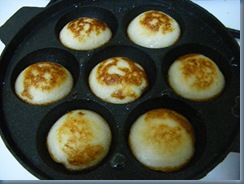They are called Gundpongalya. Here is the pronunciation guide...
Gund - pronounced just as in the Gunda(thug) without the aa sound
ponga - pronounced as in pongal
lya - pronounced as in Tendlya(the unofficial nickname for Sachin)
Now, if this is not complicated, what is?
This is a favourite of mine and so many others I know who have tasted it at my home. It used to be the rage whenever I carried it in my lunch box in school or college.
The only problem was to tell the others what it was called. The name is tough enough to pronounce even for some Kannada people I know (including D, my brother - he makes it sound like a completely alien dish). The first time I took it to school in Delhi, I received bewildered stares from all my north Indian friends when I announced that I had got Gundpongalya in my lunchbox. Inspite of the non-culinary sounding name to them, they loved it. So much so that I started getting demands from them to get it again & again. And they started referring to it as 'The round ones with the complicated name'!
Life became much easier when I discovered that they are also called 'Paddu'(rhyming with laddu). Although we still call it by the original name at home.
This is an ideal weekend breakfast for us. Sometimes even acting as lunch or dinner, if we want.
Ingredients
- 1 cup Urad Dal (Split Black Gram)
- 2 cups rice
- 2 tblsp Pohe (Beaten rice )
- 1 tsp fenugreek seeds
- 1 Onion, chopped
- Salt
- Oil to cook
Method:
Soak the Urad Dal, Rice and fenugreek seeds for 6-8 hours. Soak the Pohe 10 minutes before preparing the batter.
Grind together urad dal, fenugreek, rice & pohe just like the Dosa batter but the final batter should be coarser than the Dosa batter.
Let the batter ferment overnight. The 'Paddu' turn out light & fluffy on the inside if the batter is fermented well.
Put an Appam pan to heat. Add salt and chopped onions to the batter and mix well.
Add about 1/4 tsp oil in each of the sections of the pan. Spoon out the batter into these sections. Cover and cook for 3-4 min. Remove cover and turn them over and again cook for 2-3 minutes. Remove once they are thoroughly cooked, having a crisp outside but soft & fluffy inside.
The temperature at which the cooking is done, is very important. If the flame is too low, the Paddu will take a long time to cook and the result will not be the desired one. But if the flame is too high, the outer cover will get crisp & brown very fast and the insides will not be properly cooked. Gauge the optimum temperature while cooking the first batch and then adjust accordingly.
Serve hot with coconut chutney and/or Sambhar.
PS: Add chopped green chilies, curry leaves and ginger to the batter for a spicier version of Paddu!


looks yummy. This looks more like uppu appam what we call which is also made out of rice and urad dhall. Urs looks yummy
ReplyDeleteI loved eatin it that day at ur place :)
ReplyDeleteVidhya: Thanks.Yes, this dish appears in various forms in different regions of South India.
ReplyDeleteArchana: Thanks a lot dear! You are welcome any time :)
One dish - several cousins;) We call it morappam, and how I love this!!
ReplyDelete